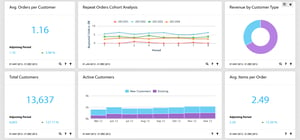 Business Intelligence… what are we actually talking about!?
Business Intelligence… what are we actually talking about!?
A Quick Guide in 6 episodes.
Today's topic – episode 5: The Customer Lifetime Value is one of the most important metrics when it comes to customer segmentation or the allocation of investments in existing customers. Why? That's what you'll learn in this blog post!
About this blog series
Business Intelligence. Is it baloney or a term that matters? Does it even concern me or will I have deleted the word from my vocabulary by tomorrow anyway? You’ve probably heard about it and read about it, but you may not have ever quite understood exactly what it means? Anyway – Business Intelligence surely is a term that leaves many people in a quandary. Maybe this is you? Then maybe we’ve got something for you: This Blog Series offers you some help by providing six successive blog articles about what we are actually talking about when we use the term Business Intelligence – based on our extensive BI-centered work in consulting and development for the online sector. For everyone who wants to know more, and in particular, for online retailers.
INDEX OF EPISODES
- Episode 1: What’s the use of Business Intelligence? Do I need that, too?
- Episode 2: BI Fundamentals – Metrics and KPIs
- Episode 3: Important Metrics for Successful eCommerce (I): Traffic, Average Session Duration, Conversion Rate, Average Order Value
- Episode 4: Important Metrics for Successful eCommerce (II): Sales Metrics, Cost-turnover Ratio, Return Rate, Customer Metrics, Repurchase Rate
- Episode 5: Important Metrics for Successful eCommerce (III): The Customer Lifetime Value Special
- Episode 6: 5 Golden Rules for your BI project – Drawing a Bottom line
Important Metrics for Successful eCommerce (III): The Customer Lifetime Value Special
Today’s discussions about “strategic optimization“, including (and especially) when it comes to eCommerce, are all about one thing: The customer. What does the customer want, what and how is he or she buying, and what do I have to offer which customer in which way to make him pack his cart in my webshop.
One impact of this customer-centered focus is everyone’s significant investment in customer retention programs. It certainly is beyond debate that this, generally speaking, is a good approach – but, as usual, you have to keep in mind what always determes your success: Doing it the right way!
Reconsider your premises: customer retention – actually my factor of success, too?
V. Kumar (2008) teaches us: Against a popular fallacy, the common slogan “customer retention!” is far from always being such a profitable one; research studies especially debunk the following common misunderstandings:
- Long-term customers are not necessarily cheaper than new customers (costs of ongoing marketing activities, communication etc. at least compensate costs all around for customer acquisition and initial support).
- Long-term customers would rather not pay higher prices than new customers (quite the opposite, they tend to show a higher price sensitivity and therefore a lower disposition to expose themselves to incremental costs).
- The role of long-term customers as an important marketing factor is commonly highly overrated.
As a result of these misunderstandings, there are far too often significant investments in expensive and time-consuming customer retention programs that altogether reduce the company’s profits more than they raise them. They don’t differentiate between customers with a low disposition to buy (who might even have already completed their lifecycle a while ago) and the most promising customers who have a high disposition to buy. Investments in the first group will probably turn out to be totally fruitless.
CONCLUSION 1:
Get rid of the stereotypes. Give me some differentiated initial conditions: Verify for yourself if long-term customers really are an important basis for revenues, before you invest heaps of money into customer retention programs.
The consequence? Success = customer retention by optimized profitability!
The critical keyword isn’t undifferentiated retention, but profitability. To keep the return on investments (ROI) positive (and with values as high as possible, please!), the following golden rule needs to be complied with:
Invest where it pays off, that is to say: Invest in those customers who actually promise to be profitable.
Today, traditional metrics for the determination of profitable customers are only providing the analytic basis: Values like the RFM (Recency Frequency Monetary Value) or the SOW (Share of Wallet), for example, are only referring to past customer performance. For this reason, they are most applicable to analyzing the customers’ previous behavior and accordingly segmenting them for certain purposes (e.g. activation to initial purchase, use of coupons/special offers etc.) – an important first step.
But nowadays, there is a second step that follows, because models oriented just towards the past, like the RFM or the SOW, can easily distort the results when being used as a means of strategic development – a customer who spent 200 Euros on shoes in my webshop yesterday isn’t necessarily going to do this ever again.
CONCLUSION 2:
What I want to know: How will my customers be buying tomorrow!?
What I need: A metric as a prognostic indicator, pointing the way while being oriented towards past and future – the Customer Lifetime Value.
Customer Lifetime Value – a few words about its calculation
Expressing the economic value of customer relations during the whole duration of the relationship between customer and company, the Customer Lifetime Value is considering the central aspect of profitability as well as the one of temporality – that is to say: it is equipped with the essential ability of prognosis. It is calculated (in several variations with varying potential of differentiation, but always within a certain presumed planning horizon) including all customer relevant revenue figures and expenses as well as a certain customer retention rate, discounted with the current rate for the raising of capital. Thus, in comparison to other metrics, it has the key advantage of combining all values determining the final profit: revenue, expenses, customer performance. The CLV is thus becoming a central measurement parameter for businesses strategic decisions.
And how does my company profit by a CLV-centered analysis?
The CLV allows for the efficient measuring and managing of, individual and aggregated, customer values (for the first time in monetary figures!). Accordingly, it is an excellent metric for the evaluation of a single business department’s efficiency and becomes an important basis for decision-making.
The additional value (concerning business strategy) of a CLV-centered data analysis consists of the following main aspects:
- On the basis of the CLV, an expedient customer segmentation becomes easily possible. The calculated values just have to be matched and the customers have to be accordingly categorized in corresponding segments. By developing individual marketing and communication strategies on this basis, investments in every customer segment can be optimized to raise the ROI to a maximum.
- The CLV also allows the extensive evaluation of marketing and communication strategies that have already been implemented. With the marketing costs being an actual part of the calculation, the question simply is: Does the particular strategy maximize the CLV or doesn’t it? This way, marketing and communication strategies can continuously be monitored, reviewed and promptly adjusted. The result? Turns out to be quite profitable.
- Additionally, recently developed distribution channels, the price system and product design can be reviewed regarding their efficiency through use of the CLV. Once more, the question is: Does my new distribution channel/my pricing policy/my product design maximize the CLV or is there unexploited potential remaining?
- The CLV can be regarded as an indicator of the company value: The sum of each customer’s CLVs corresponds to the total business’ Customer Equity that – equivalent to the Brand Equity – can be used as a measurement parameter for the company value.
CONCLUSION 3:
The Customer Lifetime Value becomes the basis of strategic decisions in various business departments.
CLV with Business Intelligence
The easiest way to start your analytic work with the Customer Lifetime Value consists of various kinds of Business Intelligence (BI) Solutions. In addition to countless other metrics with a high value for the development of your business’ strategies, capable BI Solutions should also provide you with the Customer Lifetime Value with just a click, on every requested level (individual, aggregated, etc.) and including a variety of metrics for calculation – depending on the particular system’s potential for differentiation. Because working with the CLV requires a holistic view that also includes data like returns, gross profits on sales, the customers’ age, ordering histories and cost rates from the ERP, partial solution systems, such as webtracking, are not sufficient for its calculation. A BI Solution becomes essential so that you don’t get lost in the thick forests of numbers.
CONCLUSION 4:
Calculation and business strategic inclusion of the Customer Lifetime Value can – especially with increasing degree of the calculation model’s potential of differentiation – become a mathematically and technologically very complex issue. But: The output is totally worth it – and with a qualified Business Intelligence Solution even the calculational effort becomes easily manageable.
At the end of the day…
…let’s cut a long story short: An ROI that stays positive over the long term can only be achieved by customer retention strategies that are differentiated adequately and thus meet a single customer segment’s requirements individually – according to their predicted purchasing potential. Investments in customers who excel primarily in their ability to only exist in my Rolodex equals an active waste of capital and should be avoided thoroughly.
- Analyze customers’ potentials by means of the Customer Lifetime Value!
- Optimize marketing and communication channels as well as distribution and product strategies!
- Have increasing profits as a result!
Let's read Episode 6: 5 Golden Rules for your BI project – Drawing a Bottom line
Don't feel like reading any more? You might be interested in the expert webinar with Gpredictive on the topic: In 6 Steps to Customer Lifetime Value, where a 6-point plan for determining future customer value using CLV calculation is presented. (in German only)
V. Kumar: Managing Customers for Profit. Strategies to increase profits and build loyalty. New Jersey 2008.


 nach Wunsch auch mit Videocall
nach Wunsch auch mit Videocall